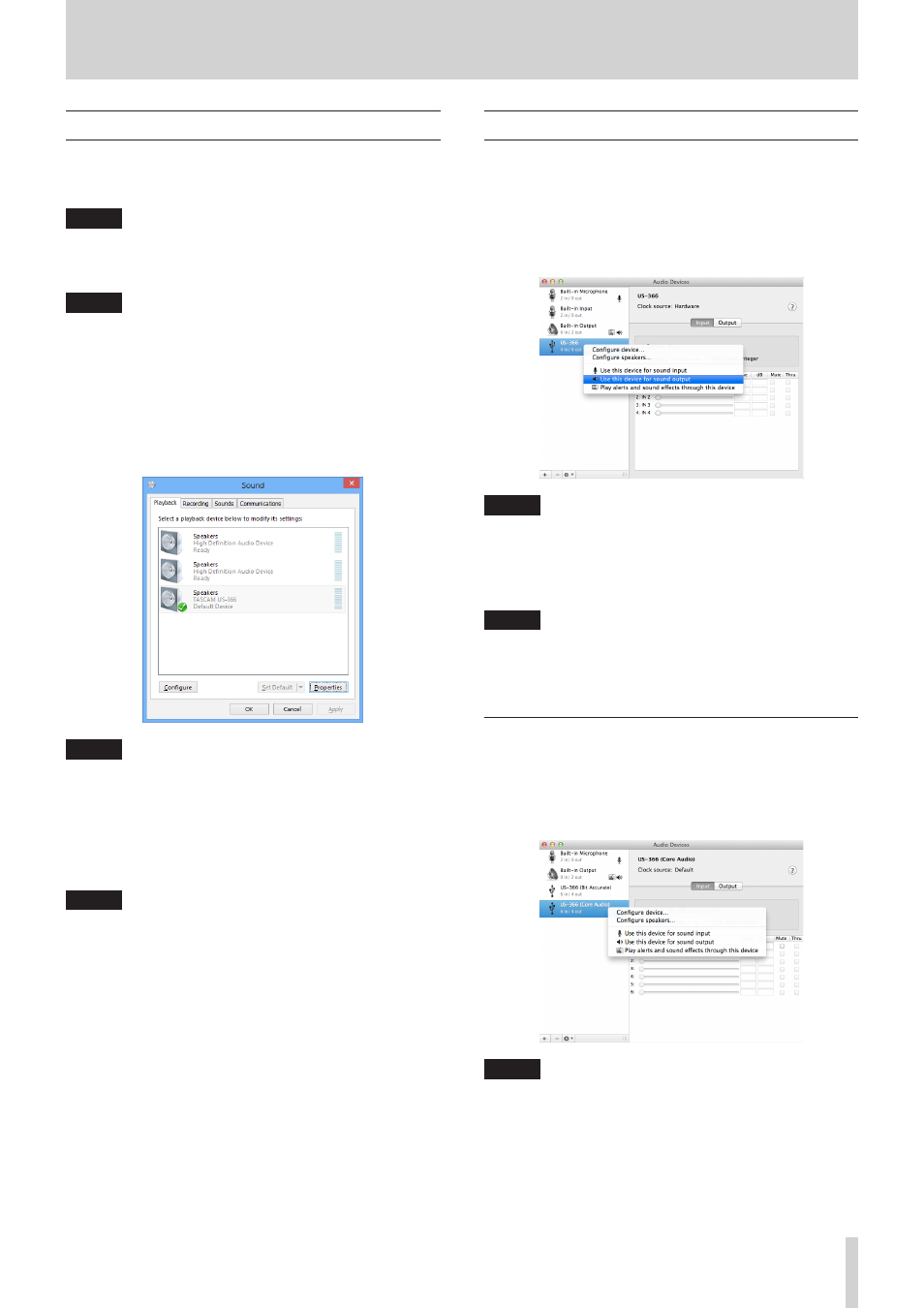Windows 8 and windows media player, Mac os x and itunes, Using audio midi setup in os x mavericks (10.9) – Teac US-366 User Manual
Page 27: Using audio midi setup, In os x mavericks (10.9), 6 – application guide

TASCAM US-366
27
6 – Application Guide
Windows 8 and Windows Media Player
1. Close all applications and right-click the Start screen and
then click the “All apps” button that is at the bottom right of
the screen to open the Apps screen.
NOTE
In Windows 8.1, click the x icon that appears at the bottom
right of the start screen.
2. Click “Control Panel”.
NOTE
You can also open the Control Panel by clicking the Control
Panel item in the menu that appears if you right-click the
bottom left corner of the desktop.
3. After clicking “Hardware and Sound”, open the Sound screen.
4. On the “Playback” page, right-click “Speakers TASCAM
US-366”, and click “Set as Default Device” in the pop-up menu
that appears.
When you do this, the green check mark (4) appears next to
“Speakers TASCAM US-366”.
NOTE
If you plan to use this unit for live broadcast over the Internet
or otherwise as a recording device, on the “Recording” page,
right-click “Line In TASCAM US-366" and click “Set as Default
Device” in the pop-up menu that appears.
5. After completing the setting, click the “OK” button.
6. Start Windows Media Player, and select and play an audio
file.
NOTE
• Windows Media Player will not recognize the device change
if you change these settings while it is running. In this case,
restart Windows Media Player.
• If you still cannot hear sound after making the settings and
completing the procedures above, disconnect the USB cable
and restart the computer.
• After making these settings, sound will be output from
this unit, but sound will not be output from the computer
speakers or headphone jack.
• If you want to output the signal from Windows Media Player
through the DIGITAL OUT without passing through the
unit's mixer, set “DIGITAL OUTPUTS” to “computer 1-2” on
the “INTERFACE” page of the Mixer Panel.
Mac OS X and iTunes
1. Double-click the Audio MIDI Setup application, which is in
the Utilities subfolder of the Applications folder, and then
open the Audio Devices window.
2. Click “US-366” to select it, and right-click or control-click
“US-366”. Then, click “Use this device for sound output” in the
pop-up menu.
The speaker mark appears next to “US-366”.
NOTE
If you plan to use this unit for live broadcast over the
Internet or otherwise as a recording device, select “Use this
device for sound input” for the “US-366”. When you do this,
the mic icon will move to “US-366”.
3. Launch iTunes, select an audio file and start playback.
NOTE
If you want to output the signal from iTunes through the
DIGITAL OUT without passing through the unit's mixer, set
“DIGITAL OUTPUTS” to “computer 1-2” on the “INTERFACE”
page of the Mixer Panel.
Using Audio MIDI setup in OS X Mavericks (10.9)
In OS X Mavericks (10.9), two options appear in the Audio
Devices list: “US-366 (Bit Accurate)” and “US-366 (Core Audio)”.
Only the “Core Audio” setting can be used as the input or output
device.
Do not use the “Bit Accurate” option.
NOTE
• When the “US-366 (Bit Accurate)” option can be selected in a
DAW or other software, using it should make recording and
playback more stable.
• The “US-366 (Bit Accurate)” option cannot be used with
applications downloaded from the Mac App Store. Use the
“US-366 (Core Audio)” option with such applications.
